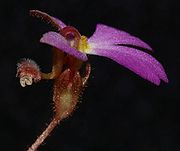
Column (botany)
Encyclopedia

Aristolochiaceae
The Aristolochiaceae, or the Birthwort family, are a family of flowering plants with 7 genera and about 400 species belonging to the order Piperales...
, Orchidaceae
Orchidaceae
The Orchidaceae, commonly referred to as the orchid family, is a morphologically diverse and widespread family of monocots in the order Asparagales. Along with the Asteraceae, it is one of the two largest families of flowering plants, with between 21,950 and 26,049 currently accepted species,...
, and Stylidiaceae
Stylidiaceae
The family Stylidiaceae is a taxon of dicotyledonous flowering plants. It consists of five genera with over 240 species, most of which are endemic to Australia and New Zealand. Members of Stylidiaceae are typically grass-like herbs or small shrubs and can be perennials or annuals...
.
It is derived from the fusion of both male and female parts (stamen
Stamen
The stamen is the pollen producing reproductive organ of a flower...
s and pistil) into a single organ. This means that the style and stigma of the pistil, with the filaments and one or more anthers, are all united.
Orchidaceae

Resupination
Resupination generally means being upside-down, supine, facing upward. The word is derived from the Latin. In a biological context, the concept is commonly expressed with the adjectives "resupinate" or "non-resupinate."-Examples in green plants:...
(the rotation by 180 degrees before unfolding of the flower).
This stigma has the form of a small bowl, the clinandrium, a viscous surface embedding the (generally) single anther. On top of it all is the anther cap. Sometimes there is a small extension or little beak to the median stigma lobe, called rostellum
Rostellum
The rostellum is a projecting part of the column in Orchidaceae flowers, and separates the male stamen from the female gynoecium, commonly preventing self-fertilisation...
.
Column wings may project laterally from the stigma. The column foot is formed by the attachment of the lip
Labellum
Labellum is the Latin diminutive of labium, meaning lip. These are anatomical terms used descriptively in biology, for example in Entomology and botany.-Botany:...
to the basal protruding part of the column. One speaks of a mentum (chin) if the lateral sepal
Sepal
A sepal is a part of the flower of angiosperms . Collectively the sepals form the calyx, which is the outermost whorl of parts that form a flower. Usually green, sepals have the typical function of protecting the petals when the flower is in bud...
s are also basally adnate (= attached to the foot of the column).
The column both releases pollen
Pollen
Pollen is a fine to coarse powder containing the microgametophytes of seed plants, which produce the male gametes . Pollen grains have a hard coat that protects the sperm cells during the process of their movement from the stamens to the pistil of flowering plants or from the male cone to the...
and also receives it (from another individual) for fertilization. In the Orchidaceae family, unlike almost all other flowering plants, the single male anther at the tip of the column produces pollen
Pollen
Pollen is a fine to coarse powder containing the microgametophytes of seed plants, which produce the male gametes . Pollen grains have a hard coat that protects the sperm cells during the process of their movement from the stamens to the pistil of flowering plants or from the male cone to the...
that is not free and powdery but held in waxy masses of two, four or six pellets called pollinia
Pollinium
Pollinium, or plural pollinia, is a coherent mass of pollen grains in a plant.They are the product of only one anther, but are transferred, during pollination, as a single unit. This is regularly seen in plants such as orchids and many species of milkweeds .Most orchids have waxy pollinia...
. The transfer of pollinia from one flower to another, though highly efficient, is often reliant upon one particular species of arthropod
Arthropod
An arthropod is an invertebrate animal having an exoskeleton , a segmented body, and jointed appendages. Arthropods are members of the phylum Arthropoda , and include the insects, arachnids, crustaceans, and others...
s and it can be catastrophic for the population if its pollinator disappears from the community.

